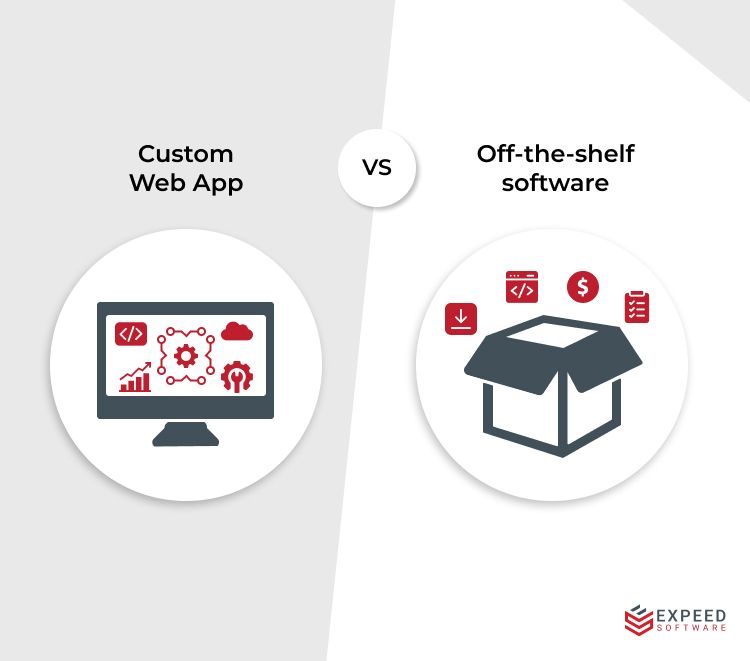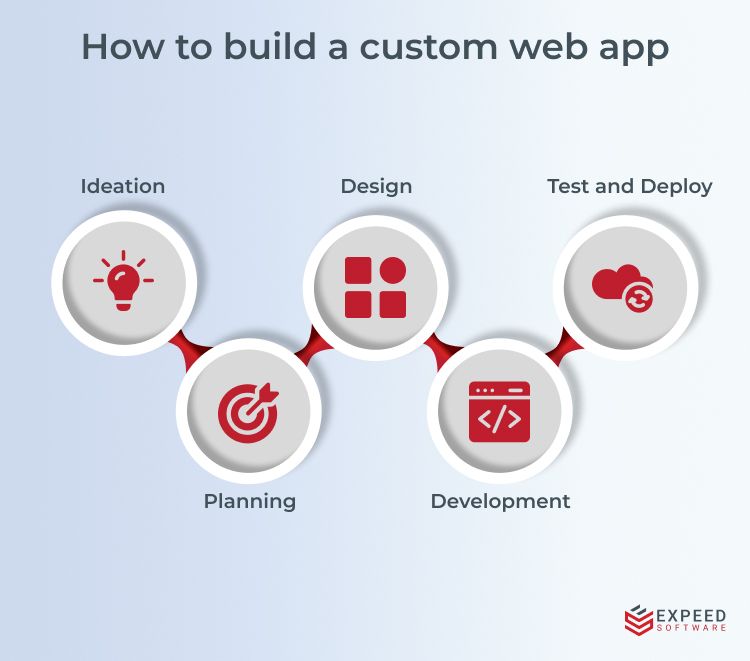Choose Right For Your Business: Custom Web App Development or Off-the-Shelf Solutions
Choosing between custom web app development and off-the-shelf solutions for an enterprise can be a difficult decision, much like choosing between a tailor-made shirt and a ready-to-wear garment. Both options have advantages and disadvantages, but the final decision should be based on the organization’s needs and characteristics.
Your choice of application to offer services to clients will be a transformative one and will reflect on the scalability and productivity of the organization. Let us weigh the benefits and drawbacks associated with approaching custom web app development companies versus the ones tied to subscribing to an off-the-shelf technology.
What are off-the-shelf solutions?
For easy understanding, off-the-shelf solutions can be defined as applications that are meant for vast commercial purposes. The target audience count of off-the-shelf or commercial software will be large.
Off-the-shelf solutions are created for mass usage and are flexible enough to integrate with multiple systems to attain a specific set of features. Compared to custom solutions, off-the-shelf solutions are cheaper to implement, although on the go you might have to pay for certain services offered by the platforms.
One of the biggest perks of off-the-shelf solutions is that they are used by a wide range of people from different sectors globally, and hence, it is easy to communicate via common forums if any bottlenecks are encountered. This keeps the customer service and updates from the developers constant, keeping up the efficiency of the tool.
These applications can be customized to a certain extent, but not more than that. Hence, most of the time, when an organization decides to depend on off-the-shelf solutions, they are forced to tweak their operations to fit the architecture and service limitations of the application.
What is a custom web application?
In contrast to off-the-shelf software designed for a large user base, custom web applications provide personalized solutions tailored to specific audiences. Building a custom web app requires meticulous planning, design, development, testing, and deployment to meet the specific requirements of clients or organizations. The process ensures scalability and targeted functionalities, resulting in a superior user experience.
How do Custom Web Apps differ from Off-The-Shelf Solutions?
What makes custom web apps more popular with certain businesses compared to off-the-shelf solutions? The answer lies in the nature of the services offered by both of these apps.
We are familiar with a lot of off-the-shelf solutions, such as Gmail, that are suitable for a wide range of businesses and sectors of clients. But when it comes to offering multiple or all required services in a specific sector, they are not much use. Although the initial adaptation to an off-the-shelf solution might not cost much, in the future, the cost of usage will increase depending on adding new users, buying licenses, migrating data, etc.

On the other hand, a custom web app is a tailor-made solution to best fit a specific business and is completely customizable as per your requirements. As we know, when it comes to web development, customization, and scalability matter the most. When a web app tends to scale as per one’s needs and requirements, it guarantees solid customer loyalty and dependency.
Flexibility is not a guarantee when it comes to off-the-shelf solutions. As you won’t get all the necessary features housed in one place, flexible performance is a question mark. This is not the case when you are using a custom web app, as scalability, flexibility, and customization are the three key features contributing to its popularity among most service-focused organizations.
While using an off-the-shelf solution, it is not necessary that you use all the features it provides. Instead, most of the time, an organization will be making use of only those features that align with its functionality, and the rest will not be utilized at all. A custom web application can house only those features that are useful for your clients and nothing more. This simply ensures the maximum utilization of technology, increasing the application’s productivity. Apart from all these, there are other perks to custom app development, such as better security, increased efficiency, automation of features, etc.
It is important to know the process of custom web app development to identify why this approach stays effective and what makes it stand out from other applications. Understanding the various stages of development involved while building an application will make the stakeholders appreciate the precision, flexibility, scalability, and adaptability of the solution. Let us take a look into the intricate process of custom web app development that injects perfection in each step to provide a tailored, customized, and efficient product for various organizations.
The process of developing Custom Web Applications
Clarity is the key. Keenly analyze your requirements to find out whether or not a custom web application is ultimately what you need. Once you have finalized on depending on a custom web app to deliver your services, you start the development process. You can either make an internal team of your organization build a custom web app or outsource the project to a custom web app development company. The latter can benefit from using your own workforce for other important work.

The custom web app development process can be divided into six stages:
- Requirement Analysis
- Finding the target audience
- Choosing the best custom web app development company
- Custom Web App Development
- Testing the application
- Deployment and maintenance
1. Requirement Analysis
This is one of the most important stages of building a custom web application. If proper analysis is not done following the rushed development of an app, the results are not going to yield anything good for your organization. Recognize your client pool’s pain points and list out the features required to meet them.
From choosing the right platform for developing your app to deciding the KPI (Key Performance Indicator) goals of the app, everything should be covered in this stage. A clear idea of the expected time required to complete development and the cost of development can be acquired through this analysis.
2. Finding Target Audience
If you are unsure of the target audience, the custom app development process can become a very tedious task. Hence, at this point, it is necessary for you to work out such details with the help of a dedicated team. Figure out things such as the total number of people who should be using your app, the age group of end-users, etc. Pick out a sector of users who are most likely to use your app and figure out the list of features and UI/UX content they will be interested in.
You can conduct client interviews to identify end users and research market trends. By making use of tools such as Google Analytics and observing your competitors, you can get a fair idea of who the web app should target.
3. Choosing the best custom web app development company
Outsourcing the best custom web app development company will do greater good for your organization to get a professional and effective web application that pleases your target audience. You can find the perfect development partner by making sure they understand your business, requirements, and target audience and have a vast amount of programming knowledge.
Make sure the quality of the application won’t be compromised during the development process, as quality boasts about effectiveness and attracts clients. While going through the potential choices of custom web app development companies, make sure they are offering cutting-edge technologies for app development and are also thorough with the testing process to ensure zero bugs and flawless performance in the future.
4. Custom Web App Development
Most of the time, a custom web app development company will be adapting the Agile development method while building an application. Even though you are not directly involved in the development process, it is good to understand the basic processes you underwent during the shaping of your application.
The Agile development strategy can be divided into six basic steps:
1. Brainstorming
2. Design
3. Development
4. Quality Assurance
5. Deployment
From brainstorming to deployment, each and every step of the custom web app development process requires the utmost amount of research and analysis. If the brainstorming is rushed, innumerable bugs are bound to pop up during the testing phase. Not to forget customer complaints. Hence, understanding customer requirements, current trends and the best UI/UX options to decide the technology to be adapted are all important in the process.
5. Quality Assurance
Always make sure that your development partner is aware of the ongoing trends in QA-focused development, such as the Test Driven Development (ATDD) process. A thorough testing process from both the developer’s and end user’s perspectives will allow you to locate any flaws in the application and make other necessary tweaks before the final release. Always remember that quality is not an option but a necessity to make sure you will stay at the top of the market for a long time with an increasing client base.
6. Deployment and Maintenance
Once the testing is done and the bugs are fixed, it is time to deploy the application. Especially when it comes to custom web applications, it doesn’t stop with deploying the app; maintenance is a must. Post-deployment maintenance is integral to making sure that your clients are pleased and that the required updates are made to the application on time.
Start collecting feedback from your target audience at regular intervals to get an idea of possible improvisations in the application. Once the custom application is live, you can compare its performance to see if your KPI is met, and if not, figure out the necessary steps to make the application more effective to deliver an optimum user experience.
Final Word
Digital business is a vast playground, and you should always be at the forefront to score big. Depending on commercial, off-the-shelf solutions can hold you back and hinder your company’s performance. As transformation is inevitable and a consistent fact in digital real estate, your application too should be scalable enough to change according to the switching demands of clients.
While off-the-shelf solutions appear as a low-cost way of managing things at a surface level, they force you to scale your organization’s functioning within its parameters rather than letting the organization scale the app. Such friction will affect the overall performance and even project deadlines of your company. To avoid such bottlenecks when entering the digital realm, most organizations have implemented custom web apps.
Choosing the right solution—custom web app development or off-the-shelf software—is critical to an enterprise’s future. Custom web apps provide unparalleled customization and scalability while closely aligning with organizational goals and user preferences. To embark on this transformative journey, collaboration with a reputable custom web app development company is critical to success.
Expeed Software has been in the top league for years as a custom web app development company and is renowned for providing quality and efficient custom web applications. Join hands with Expeed to let your organization accelerate toward success, delivering the best and most customer-friendly user experience with custom web applications.

Expeed Software is a global software company specializing in application development, data analytics, digital transformation services, and user experience solutions. As an organization, we have worked with some of the largest companies in the world, helping them build custom software products, automate processes, drive digital transformation, and become more data-driven enterprises. Our focus is on delivering products and solutions that enhance efficiency, reduce costs, and offer scalability.


